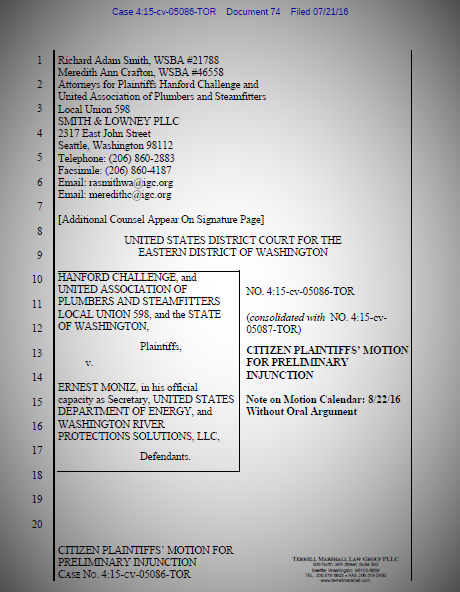Chemical Vapor Exposures
Over 50 workers have required medical evaluation after vapor exposures since April 2016, and some are still experiencing negative health effects from exposures.
Over 1,800 chemicals have been documented in the vapors contained within Hanford’s tank headspaces and which escape through various pathways.
Workers who have been exposed to toxic vapors have suffered serious long-term health effects including brain damage, lung disease, nervous system disorders, and cancer. Short-term health effects include nosebleeds, profuse sweating, persistent headaches, tearing eyes, burning skin and lungs, coughing, sore throats, eye problems, dizziness, nausea, memory loss, difficulty breathing, and increased heart rates. Some workers are on long-term disability resulting from chemical vapor exposure at Hanford, with illnesses such as toxic encephalopathy, neurological damage, nerve damage, and lung disease. Others are still fighting for their claims to be recognized. A 1997 PNNL study found that cancer risks from exposure to tank vapors carried a fatal cancer risk as high as 1 in 10.
There has been a consistent stream of exposure reports since the 1980's.
The vapor exposure controversy is historical. Numerous oversight investigations were conducted by the DOE, Congress, and the Inspector General in the early 1990s after 16 exposure incidents took place over a 4.5 year period. The resulting reports found gross mismanagement and potentially criminal activity in failing to protect workers from known hazards, and reforms were briefly instituted.
In 2006, CH2M Hill issued the Industrial Hygiene Chemical Vapor Technical Basis. Hanford Challenge reviewed this report and raised numerous concerns. Hanford Challenge and CH2M Hill, both members of the Hanford Concerns Council (HCC), brought these concerns forward for an independent review which resulted in a 2008 report. A key finding exposed doubt about the credibility of vapor sampling data and concluded that the protective measures being used were not conservative enough to protect workers.
Chemical Vapors: Q&A
What chemicals are in Hanford's tank headspaces?
Over 2,000 chemicals have been documented in the vapors in Hanford tank headspaces. Chemicals potentially venting from the tanks include dimethyl mercury, benzene, carbon tetrachloride, and n-nitrosodimethylamine (NDMA), among others.
What are the possible health effects of exposure to tank vapors?
Workers who have been exposed to tank vapors have suffered numerous acute and long-term health effects. These include nosebleeds, metallic taste in the mouth, headaches, coughing, sore throats, nausea, and increased heart rates. Workers have developed chronic obstructive pulmonary disease, decrease in lung capacity, toxic encephalopathy, and cancer as a result of exposure to tank vapors. Some have ended up on long term disability after an exposure.
What studies have been done into tank vapors at Hanford?
A number of studies on tank vapors at the Hanford Site have been conducted, included the 2003 Government Accountability Project report "Knowing Endangerment: Worker Exposure to Toxic Vapors at the Hanford Tank Farms."
What resources are available for workers who have suffered adverse health effects after a chemical vapor exposure?
We are working on updating our site to include the most up to date chemical vapor exposure resources for workers. In the meantime, please email info@hanfordchallenge.org with questions and concerns.











